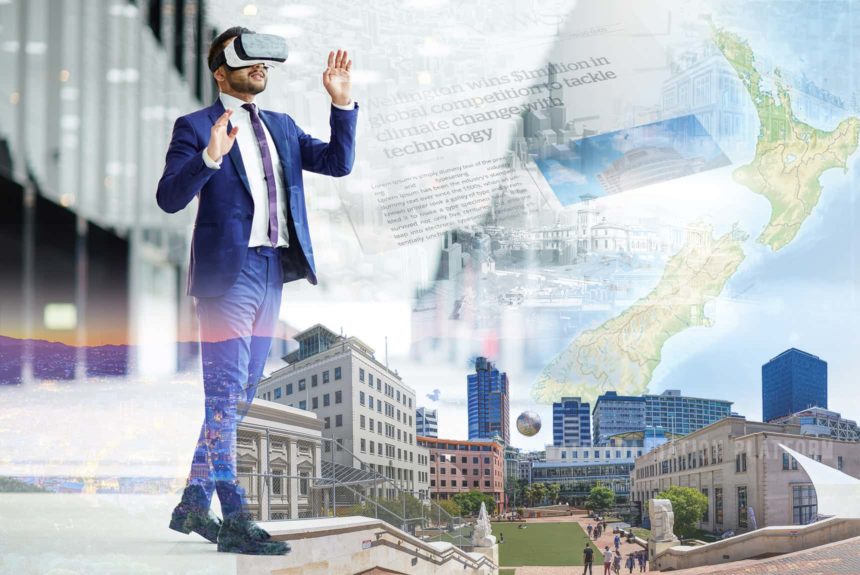Digital twins are virtual models or digital representations of assets or objects. It involves a live stream of data and connection to the real world via the internet of things (IoT) sensors.
The digital twin functions like the real thing it represents, allowing users to simulate and learn from it and apply these learnings to the actual assets or objects.
Wellington city, the capital of New Zealand, has created a digital twin of the city to allow its residents, local government, city planners, and engineers to see the impacts of climate change.
“As a coastal city that is highly exposed to climate change impacts and with few options for relocating infrastructure, businesses and homes, it’s critical we enable evidence-based climate adaptation decisions in the next two to three years to respond to the climate and ecological emergencies declared by Council,” says Julia Hamilton, team leader of digital innovation at Wellington City Councils (Molyneux, 2022).
Molyneux (2022) reports that the project Wellington City led was one of the 15 innovative initiatives that address climate change worldwide and will be awarded US$1 million in the Bloomberg Mayors Challenge. The money will support the development of the video game-like version of the capital.
Wannan (2022) says:
“From a screen, users will be able to travel back to the city’s past and into the future, modelled on the latest scientific projections. They’ll be able to see what protections against the rising tides – from sea walls to mangroves – will look like, cost and how long they’ll last. The council hopes the tool will simplify a challenging yet critical topic and boost citizen engagement.”
“Many of the impacts of climate change take decades or centuries to take effect, so future generations will be hit by sea-level rise, heavier rainfall and more violent storms even if the world makes drastic cuts to emissions today. Much of the work helping residents to adapt to these effects will be overseen by councils. This job will be particularly problematic in cities – including Wellington – where billions of dollars of buildings, facilities and housing are exposed.”
Through simulations, citizens can see the impacts of climate change in their city, which could encourage engagement and inputs that would help the council come up and implement a climate adaptation strategy, especially in vulnerable areas where the retreat is a possibility.
What is a Digital Twin?
It provides a framework for creating the digital truth about the physical environment. Through simulations that show the cause and effect of an event happening, it can help policymakers and decision-makers make informed decisions to prevent incidents from occurring or mitigate the event’s impacts.
Digital twins would seem like new technology, but they have existed for a long time. The digital twin concept gained recognition in 2002 when it was used to present the development of a product lifecycle management. But as a concept, it had existed since the 1960s when NASA used basic twinning ideas for space programming.
In 1970, NASA had created the digital twin of the Apollo 13 that had become a crucial tool for the astronauts’ survival in space when the ship encountered a problem – the bursting on the oxygen tanks early into the mission (Miskinis, 2019).
Recently there has been a renewed interest in the technology as engineers, architects, city planners, can now combine these technologies – sensors, 3D, and the IoT to create a virtual model of an object that also supplies real-time data and information.
“The potential for digital twin cities is endless, from informing all aspects of civil engineering and city planning to aiding the vision of future infrastructure” (Wellington Digital Twin, 2021).
Hence, digital twins present a tool to help tackle our modern-day problems of climate change, rapid urbanisation, population growth, resource sustainability, and environmental degradation.
Digital twins are pretty complex and involve many layers and components, and depending on the users, features of the digital twin can vary. For example, policymakers may use the digital twin differently from engineers, urban planners, or architects.
Why do we need digital twins now when engineers and city planners have successfully built cities and structures for centuries without this technology?
Yes, this is true; however, the new challenges that our planet is facing right now – environmental degradation, rapid urbanisation, climate change, sustainability, among many others call for innovative or better ways to tackle these problems. Thankfully, continuing advances in technology make this possible.
Digital twins allow engineers and designers to see how the object, building, or structure works, or what works or what doesn’t before it is built, providing quicker and faster feedback, thus saving costs, especially from a bad design or when things need fixing.
Structures and buildings that have been built for centuries and even those constructed in the mid-century would now be at the end of their lifecycle. This means that now is the time for major renovation, retrofits, or replacement.
Sensors, 3D, and the IoT used in digital twins provide evidence-based data to help engineers and urban planners make educated and targeted interventions and investments to improve assets or structures’ service or performance level, significantly reducing costs and time.
Buildings account for around 40% of global GHG emissions. Digital twins can assist in making existing buildings and the design of new ones more energy-efficient buildings to reduce the amounts of energy they use for heating and cooling, which can significantly lower their carbon footprint.
Sources:
Molyneux, V. (2022, January 18). Wellington wins $1million in global competition to tackle climate change with technology. NZ Herald. Retrieved from https://www.nzherald.co.nz/nz/wellington-wins-1million-in-global-competition-to-tackle-climate-change-with-technology/4Y3K7RKUN7IMMMNQIJLZZ2EUUQ/
Wannan, O. (2022, January 18). Wellington project puts climate change into the video game world with $1m award. Stuff. Retrieved from https://www.stuff.co.nz/environment/climate-news/127528198/wellington-project-puts-climate-change-into-the-video-game-world-with-1m-award
Miskinis, C. (2019, March). The history and creation of the digital twin concept. Challenge Advisor. Retrieved from https://www.challenge.org/insights/digital-twin-history/
Wellington Digital Twin. (2019). Buildmedia. Retrieved from https://buildmedia.com/work/wellington-digital-twin



Leave a Reply